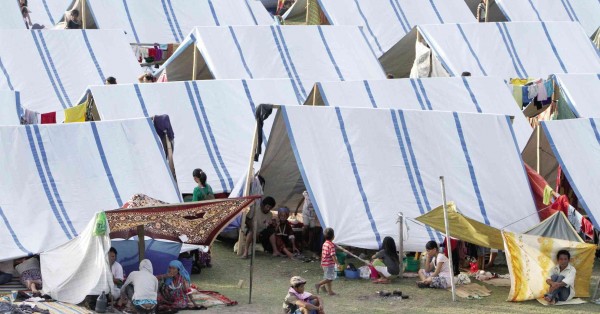Death, hunger, illness for Zamboanga evacuees
ZAMBOANGA CITY—More than 60 people, many of them children and the elderly, have succumbed to various illnesses in evacuation camps and relocation sites for people displaced by fighting between government security forces and guerrillas of the Moro National Liberation Front here last September, the city’s health officer said Thursday.
More than 100 persons were killed and 100,000 others displaced in the fighting, which lasted for three weeks from Sept. 9, with thousands of houses destroyed by fire or bombs and other explosives.
Dr. Rodelin Agbulos said on Thursday that among the major killers in the evacuation camps were pneumonia and diarrhea.
Lea Ruth Gamboa, team leader of Red Cross’ Basic Health Care Unit at an evacuation center here where 11,565 people continue to live in filthy conditions as they await relocation, said the diseases cited by Agbulos were on the rise along with chicken pox, dengue and measles.
“Red Cross does not give figures or numbers of deaths and illnesses,” she said, pointing out that the local health office could provide the data.
Article continues after this advertisementAgbulos confirmed that conditions in the evacuation centers were the main factor in the high incidence of disease.
Article continues after this advertisement“We are consolidating our reports but what I know is that there are more than 60 now,” he said of the number of deaths in the evacuation camps.
Gamboa said people were dying of such things as dehydration because they did not have to money for hospit6alization.
“The free hospitalization for them provided by the government has ended,” Gamboa said. “When someone gets sick, the family would immediately ask if the patient could be sent to the hospital for free. If they are told it wouldn’t be, they lose interest.”
She said the Red Cross continues to intervene to make the evacuees more resilient against disease, especially children, by providing them nutrient-packed food.
The frail and the elderly are also being isolated in bunkhouses built by the International Organization for Migration (IOM).
Maria Socorro Rojas of the Department of Social Welfare and Development in Western Mindanao said the large number of evacuees—21,666 individuals in 10 different evacuation centers— was proving to be a problem but the government was doing everything to help them.
Rojas confirmed that the DSWD has ended its free food rations to the evacuees but said that food was being provided to the evacuees in exchange for work. Evacuees who agreed to talk to the Inquirer said the food-for-work scheme was implemented only once.
“It wasn’t repeated and we are cash-strapped to even buy rice,” said Omar Mohammad, 38, a father of two.
Omar said he got 25 kilograms of rice in December in exchange for sweeping streets for two weeks.
“It’s gone now,” he added.
Aminah Mohadji, 35, said she had only two cups of rice left and that her family of 10 has been susbsisting on rice porridge every day.
Margani Suraji, caretaker of the makeshift mosque inside the Don Julian Rodriguez Memorial Complex here, said hunger was making people sick and the lack of money to have patients treated at hospital worsened their condition.
“Recently, the number of people being buried each week rose to two,” Suraji said.
“We are basically on our own now as the government has its hands full with the Yolanda victims these days,” he added.
Related Stories:
Kids die of illnesses in Zamboanga City evacuation centers
UN gives P126M to help Zamboanga evacuees
Gov’t calls for more aid to Zamboanga evacuees
